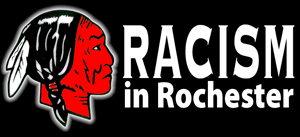Chronology of recent events regarding American Indian mascots and imagery
The NCAA News — April 23, 2001
By Kay Hawes
The NCAA News
A chronology of recent events pertaining to American Indian mascots and images in college athletics:
December 20, 2000: Ralph Engelstad, an alumnus of the University of North Dakota, tells North Dakota President Charles E. Kupchella and the state's board of higher education that he will cease construction on a $100 million hockey arena if the Sioux logo and slogan are changed. "Commitments were made to me by others and yourself, regarding the Sioux logo and the Sioux slogan, before I started the arena and after it had been started," Engelstad writes. "Please be advised that if this logo and slogan are not approved by you no later than Friday, December 29, 2000, then you will leave me with no alternative to take the action which I think is necessary. ...If I walk away and abandon the project, please be advised that we will shut off all temporary heat going to this building, and I am sure that nature, through its cold weather, will completely destroy any portion of the building through frost that you might be able to salvage."
December 21, 2000: The North Dakota State Board of Higher Education votes to retain the nickname "Fighting Sioux," along with an Indian head logo.
February 23, 2001: The Chronicle of Higher Education publishes "A battle over a name in the land of the Sioux," detailing the North Dakota situation with Ralph Engelstad.
March 2, 2001: Michael Aiken, chancellor at the University of Illinois, Champaign, requires faculty and students to clear any contact or correspondence with a potential athletics recruit through the department of athletics. Aiken was responding to plans by an Illinois faculty group to contact recruits and inform them of the Chief Illiniwek debate.
March 15, 2001: Roy H. Saigo, St. Cloud State University president, asks the NCAA Division II Presidents Council to consider the American Indian mascot issue and also to consider a resolution stating the NCAA does not condone the use of Native American logos and nicknames.
March 21, 2001: The Midwest Summit on American Indian Mascots brings 1,200 people to the campus of St. Cloud State to discuss the issue.
March 22, 2001: The American Civil Liberties Union and the National Coalition on Racism in Sports and the Media file suit against officials at the University of Illinois, Champaign, in response to Aiken's e-mail announcing a policy requiring athletics department clearance before contact with athletics recruits. The plaintiffs, who include Illinois faculty, argue that the policy restricts free speech.
March 23, 2001: Charles E. Kupchella, president of the University of North Dakota, issues a letter to university faculty, staff and students, asking for civility in the debate over the "Fighting Sioux" nickname and imagery. "In recent weeks, there has certainly been an escalation in the harshness of the rhetoric and shrillness in the exchange between those on opposing sides," Kupchella writes. "What I hear causes me great concern for the safety of both Native American students and other students, as well. There have been reports of threats, harassment, and intimidation. Such behavior has no place in a university. In addition to my call for civility, I want to state very plainly that behavior that violates local, state and/or national law will not be tolerated."
April 5, 2001: U.S. District Court Judge Michael Mihm grants a temporary restraining order against a policy announced in March by the University of Illinois, Champaign. The judge rules that the university cannot require faculty members and students to seek permission to talk to recruits about the American Indian mascot controversy at the school.
April 5, 2001: The New York State Education Department calls for New York public schools to "end the use of Native American mascots as soon as practical," noting that such practices "can become a barrier to building a safe and nurturing school community and improving academic achievement for all students."
April 12, 2001: U.S. District Court Judge Michael Mihm, attorneys representing the University of Illinois, Champaign, and the American Civil Liberties Union of Illinois agree via teleconference to extend a temporary restraining order until a hearing June 1. During the temporary restraining order, the university is barred from enforcing a requirement that faculty and students get athletics department clearance before contacting potential athletics recruits. Stephen Kaufman, an Illinois biology professor and a plaintiff, announces that the group will begin contacting potential student-athletes to inform them of Chief Illiniwek and the faculty's position that the mascot is racist.
April 13, 2001: Saying the use of American Indian names and mascots may violate anti-discrimination laws, the U.S. Commission on Civil Rights (USCCR) calls for an end to their use by non-Indian schools, colleges and universities. The commission says American Indian names and mascots could be viewed as "disrespectful and offensive'' by Indian groups and can create "a racially hostile educational environment that may be intimidating to Indian students." The USCCR's statement reads: "Schools should not use their influence to perpetuate misrepresentations of any culture or people. Stereotypes of American Indians teach all students that stereotyping of minority groups is acceptable, a dangerous lesson in a diverse society." The group's recommendation does not carry the weight of law.
This content can be found at ncaa.org
© The National Collegiate Athletic Association
